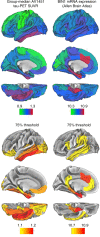The BIN1 rs744373 SNP is associated with increased tau-PET levels and impaired memory
- PMID: 30992433
- PMCID: PMC6467911
- DOI: 10.1038/s41467-019-09564-5
The BIN1 rs744373 SNP is associated with increased tau-PET levels and impaired memory
Abstract
The single nucleotide polymorphism (SNP) rs744373 in the bridging integrator-1 gene (BIN1) is a risk factor for Alzheimer's disease (AD). In the brain, BIN1 is involved in endocytosis and sustaining cytoskeleton integrity. Post-mortem and in vitro studies suggest that BIN1-associated AD risk is mediated by increased tau pathology but whether rs744373 is associated with increased tau pathology in vivo is unknown. Here we find in 89 older individuals without dementia, that BIN1 rs744373 risk-allele carriers show higher AV1451 tau-PET across brain regions corresponding to Braak stages II-VI. In contrast, the BIN1 rs744373 SNP was not associated with AV45 amyloid-PET uptake. Furthermore, the rs744373 risk-allele was associated with worse memory performance, mediated by increased global tau levels. Together, our findings suggest that the BIN1 rs744373 SNP is associated with increased tau but not beta-amyloid pathology, suggesting that alterations in BIN1 may contribute to memory deficits via increased tau pathology.
Conflict of interest statement
The authors declare no competing interests.
Figures






Similar articles
-
The BIN1 rs744373 Alzheimer's disease risk SNP is associated with faster Aβ-associated tau accumulation and cognitive decline.Alzheimers Dement. 2022 Jan;18(1):103-115. doi: 10.1002/alz.12371. Epub 2021 Jun 1. Alzheimers Dement. 2022. PMID: 34060233
-
Bridging Integrator 1 (BIN1) Genotypes Mediate Alzheimer's Disease Risk by Altering Neuronal Degeneration.J Alzheimers Dis. 2016 Mar 15;52(1):179-90. doi: 10.3233/JAD-150972. J Alzheimers Dis. 2016. PMID: 27003210
-
sTREM2 Mediates the Correlation Between BIN1 Gene Polymorphism and Tau Pathology in Alzheimer's Disease.J Alzheimers Dis. 2024;101(2):693-704. doi: 10.3233/JAD-240372. J Alzheimers Dis. 2024. PMID: 39240638
-
The Mechanistic Role of Bridging Integrator 1 (BIN1) in Alzheimer's Disease.Cell Mol Neurobiol. 2021 Oct;41(7):1431-1440. doi: 10.1007/s10571-020-00926-y. Epub 2020 Jul 27. Cell Mol Neurobiol. 2021. PMID: 32719966 Free PMC article. Review.
-
BIN1 in the Pursuit of Ousting the Alzheimer's Reign: Impact on Amyloid and Tau Neuropathology.Neurotox Res. 2023 Dec;41(6):698-707. doi: 10.1007/s12640-023-00670-3. Epub 2023 Oct 17. Neurotox Res. 2023. PMID: 37847429 Review.
Cited by
-
Genome-wide association study in Alzheimer's disease: a bibliometric and visualization analysis.Front Aging Neurosci. 2023 Nov 29;15:1290657. doi: 10.3389/fnagi.2023.1290657. eCollection 2023. Front Aging Neurosci. 2023. PMID: 38094504 Free PMC article.
-
Lack of association between bridging integrator 1 (BIN1) rs744373 polymorphism and tau-PET load in cognitively intact older adults.Alzheimers Dement (N Y). 2022 Feb 23;8(1):e12227. doi: 10.1002/trc2.12227. eCollection 2022. Alzheimers Dement (N Y). 2022. PMID: 35229019 Free PMC article.
-
Neuronal BIN1 Regulates Presynaptic Neurotransmitter Release and Memory Consolidation.Cell Rep. 2020 Mar 10;30(10):3520-3535.e7. doi: 10.1016/j.celrep.2020.02.026. Cell Rep. 2020. PMID: 32160554 Free PMC article.
-
A transcriptome-wide association study identifies novel blood-based gene biomarker candidates for Alzheimer's disease risk.Hum Mol Genet. 2021 Dec 27;31(2):289-299. doi: 10.1093/hmg/ddab229. Hum Mol Genet. 2021. PMID: 34387340 Free PMC article.
-
GWAS-Top Polymorphisms Associated With Late-Onset Alzheimer Disease in Brazil: Pointing Out Possible New Culprits Among Non-Coding RNAs.Front Mol Biosci. 2021 Jul 5;8:632314. doi: 10.3389/fmolb.2021.632314. eCollection 2021. Front Mol Biosci. 2021. PMID: 34291080 Free PMC article.

